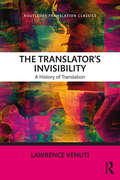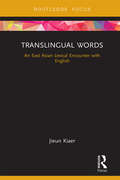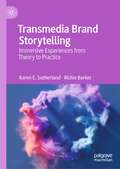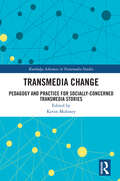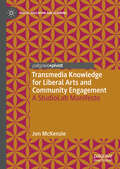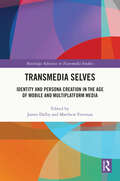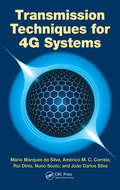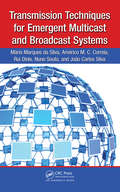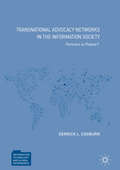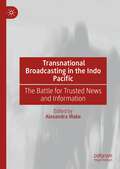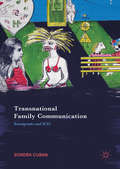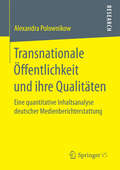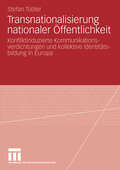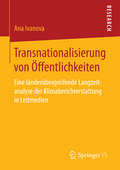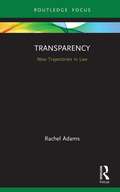- Table View
- List View
The Translator's Invisibility: A History of Translation (Routledge Translation Classics)
by Lawrence VenutiSince publication over twenty years ago, The Translator’s Invisibility has provoked debate and controversy within the field of translation and become a classic text. Providing a fascinating account of the history of translation from the seventeenth century to the present day, Venuti shows how fluency prevailed over other translation strategies to shape the canon of foreign literatures in English and investigates the cultural consequences of the receptor values which were simultaneously inscribed and masked in foreign texts during this period. Reissued with a new introduction, in which the author provides a clear, detailed account of key concepts and arguments in order to issue a counterblast against simplistic interpretations, The Translator’s Invisibility takes its well-deserved place as part of the Routledge Translation Classics series. This book is essential reading for students of translation studies at all levels.
The Translator's Invisibility: A History of Translation (Routledge Translation Classics)
by Lawrence VenutiSince publication over twenty years ago, The Translator’s Invisibility has provoked debate and controversy within the field of translation and become a classic text. Providing a fascinating account of the history of translation from the seventeenth century to the present day, Venuti shows how fluency prevailed over other translation strategies to shape the canon of foreign literatures in English and investigates the cultural consequences of the receptor values which were simultaneously inscribed and masked in foreign texts during this period. Reissued with a new introduction, in which the author provides a clear, detailed account of key concepts and arguments in order to issue a counterblast against simplistic interpretations, The Translator’s Invisibility takes its well-deserved place as part of the Routledge Translation Classics series. This book is essential reading for students of translation studies at all levels.
Translingual Words: An East Asian Lexical Encounter with English
by Jieun KiaerTranslingual Words is a detailed case study on lexical integration, or mediation, occurring between East Asian languages and English(es). In Part I, specific examples from global linguistic corpora are used to discuss the issues involved in lexical interaction between East Asia and the English-speaking world. Part II explores the spread of East Asian words in English, while Part III discusses English words which can be found in East Asian languages. Translingual Words presents a novel approach on hybrid words by challenging the orthodox ideas on lexical borrowing and explaining the dynamic growth of new words based on translingualism and transculturalism.
Translingual Words: An East Asian Lexical Encounter with English
by Jieun KiaerTranslingual Words is a detailed case study on lexical integration, or mediation, occurring between East Asian languages and English(es). In Part I, specific examples from global linguistic corpora are used to discuss the issues involved in lexical interaction between East Asia and the English-speaking world. Part II explores the spread of East Asian words in English, while Part III discusses English words which can be found in East Asian languages. Translingual Words presents a novel approach on hybrid words by challenging the orthodox ideas on lexical borrowing and explaining the dynamic growth of new words based on translingualism and transculturalism.
Transmedia Brand Storytelling: Immersive Experiences from Theory to Practice
by Karen E. Sutherland Richie BarkerThis book presents new global research on transmedia storytelling as a form of brand communication. It explores the theoretical underpinnings of transmedia storytelling and its practical application through survey and interview data from creatives, marketing, advertising and public relations practitioners. The final section analyzes contemporary campaigns from various countries and proposes a Transmedia Brand Storytelling Model for Practice, based on primary and secondary research data. The book aims to better understand and communicate the real-world opportunities and barriers to producing transmedia brand storytelling campaigns for practitioners.
Transmedia Change: Pedagogy and Practice for Socially-Concerned Transmedia Stories (Routledge Advances in Transmedia Studies)
by Kevin MoloneyThis book examines and illustrates the use of design principles, design thinking, and other empathy research techniques in university and public settings, to plan and ethically target socially-concerned transmedia stories and evaluate their success through user experience testing methods. All media industries continue to adjust to a dispersed, diverse, and dilettante mediascape where reaching a large global audience may be easy but communicating with a decisive and engaged public is more difficult. This challenge is arguably toughest for communicators who work to engage a public with reality rather than escape. The chapters in this volume outline the pedagogy and practice of design, empathy research methods for story development, transmedia logics for socially-concerned stories, development of community engagement and the embrace of collective narrative, art and science research collaboration, the role of mixed and virtual reality in prosocial communication, ethical audience targeting, and user experience testing for storytelling campaigns. Each broad topic includes case examples and full case studies of each stage in production. Offering a detailed exploration of a fast-emerging area, this book will be of great relevance to researchers and university teachers of socially-concerned transmedia storytelling in fields such as journalism, documentary filmmaking, education, and activism.
Transmedia Change: Pedagogy and Practice for Socially-Concerned Transmedia Stories (Routledge Advances in Transmedia Studies)
by Kevin MoloneyThis book examines and illustrates the use of design principles, design thinking, and other empathy research techniques in university and public settings, to plan and ethically target socially-concerned transmedia stories and evaluate their success through user experience testing methods. All media industries continue to adjust to a dispersed, diverse, and dilettante mediascape where reaching a large global audience may be easy but communicating with a decisive and engaged public is more difficult. This challenge is arguably toughest for communicators who work to engage a public with reality rather than escape. The chapters in this volume outline the pedagogy and practice of design, empathy research methods for story development, transmedia logics for socially-concerned stories, development of community engagement and the embrace of collective narrative, art and science research collaboration, the role of mixed and virtual reality in prosocial communication, ethical audience targeting, and user experience testing for storytelling campaigns. Each broad topic includes case examples and full case studies of each stage in production. Offering a detailed exploration of a fast-emerging area, this book will be of great relevance to researchers and university teachers of socially-concerned transmedia storytelling in fields such as journalism, documentary filmmaking, education, and activism.
Transmedia Knowledge for Liberal Arts and Community Engagement: A StudioLab Manifesto (Digital Education and Learning)
by Jon McKenzieThis book sets forth a pedagogy for renewing the liberal arts by combining critical thinking, media activism, and design thinking. Using the StudioLab approach, the author seeks to democratize the social and technical practices of digital culture just as nineteenth century education sought to democratize literacy. This production of transmedia knowledge—from texts and videos to comics and installations—moves students between seminar, studio, lab, and field activities. The book also wrestles with the figure of Plato and the very medium of knowledge to re-envision higher education in contemporary societies, issuing a call for community engagement as a form of collective thought-action.
Transmedia Selves: Identity and Persona Creation in the Age of Mobile and Multiplatform Media (Routledge Advances in Transmedia Studies)
by James Dalby Matthew FreemanThis book examines the mediated shift in the contemporary human condition, focusing on the ways in which we synthesise with media content in daily life, essentially transmediating ourselves into new forms and (re)creating ourselves across media. Across an international roster of essays, this book establishes a transdisciplinary theory for the ‘transmedia self’, exploring how technological ubiquity and digital self-determination combine with themes and disciplines such as celebrity culture, fandom, play, politics, and ultimately broader self-conception and projection to inform the creation of transmedia identities in the twenty-first century. Specifically, the book repositions transmediality as key to understanding the formation of identity in a post-digital media culture and transmedia age, where our lives are interlaced, intermingled, and narrativised across a range of media platforms and interfaces. This book is ideal for scholars and students interested in transmedia storytelling, cultural studies, media studies, sociology, philosophy, and politics.
Transmedia Selves: Identity and Persona Creation in the Age of Mobile and Multiplatform Media (Routledge Advances in Transmedia Studies)
This book examines the mediated shift in the contemporary human condition, focusing on the ways in which we synthesise with media content in daily life, essentially transmediating ourselves into new forms and (re)creating ourselves across media. Across an international roster of essays, this book establishes a transdisciplinary theory for the ‘transmedia self’, exploring how technological ubiquity and digital self-determination combine with themes and disciplines such as celebrity culture, fandom, play, politics, and ultimately broader self-conception and projection to inform the creation of transmedia identities in the twenty-first century. Specifically, the book repositions transmediality as key to understanding the formation of identity in a post-digital media culture and transmedia age, where our lives are interlaced, intermingled, and narrativised across a range of media platforms and interfaces. This book is ideal for scholars and students interested in transmedia storytelling, cultural studies, media studies, sociology, philosophy, and politics.
Transmission Medium (tactile)
by RnibThis diagram shows a high speed medium. 4 routers are linked in an elipse. The line connecting them is labelled as a high-speed backbone. A hub is joined onto the bottom router and has 3 pcs coming from it. The links from pc to hub are labelled ethernet.
Transmission Techniques for 4G Systems
by Mario Marques da Silva Americo Correia Rui Dinis Nuno Souto Joao Carlos SilvaFourth Generation (4G) wireless communication systems support current and emergent multimedia services such as mobile TV, social networks and gaming, high-definition TV, video teleconferencing, and messaging services. These systems feature the All-over-IP concept and boast improved quality of service. Several important R&D activities are curren
Transmission Techniques for 4G Systems
by Mario Marques da Silva Americo Correia Rui Dinis Nuno Souto Joao Carlos SilvaFourth Generation (4G) wireless communication systems support current and emergent multimedia services such as mobile TV, social networks and gaming, high-definition TV, video teleconferencing, and messaging services. These systems feature the All-over-IP concept and boast improved quality of service. Several important R&D activities are curren
Transmission Techniques for Emergent Multicast and Broadcast Systems
by Mario Marques da Silva Americo Correia Rui Dinis Nuno Souto Joao Carlos SilvaDescribing efficient transmission schemes for broadband wireless systems, Transmission Techniques for Emergent Multicast and Broadcast Systems examines advances in transmission techniques and receiver designs capable of supporting the emergent wireless needs for multimedia broadcast and multicast service (MBMS) requirements. It summarizes the resea
Transnational Advocacy Networks in the Information Society: Partners or Pawns? (Information Technology and Global Governance)
by Derrick L. CogburnThis book examines the role of transnational advocacy networks in enabling effective participation for individual citizens in the deliberative processes of global governance. Contextualized around the international conference setting of the United Nations-sponsored World Summit on the Information Society (WSIS) in 2003 and 2005, the book sees epistemic communities and information and communication technologies (ICTs) as critical to the effectiveness of this important organizational form. Historically, governments have dominated the official “conference diplomacy” surrounding these World Summits. However, reflecting the UN General Assembly resolution authorizing WSIS, transnational civil society and private sector organizations were invited to participate as official partners in a multistakeholder dialogue at the summit alongside the more traditional governments and international organizations. This book asks: are transnational advocacy networks active in the global information society influential partners in these global governance processes, or merely symbolic tokens—or pawns? Cogburn explores the factors that enabled some networks—such as the Internet Governance Caucus—to persist and thrive, while others failed, and sees linkages with epistemic communities—such as the Global Internet Governance Academic Network—and ICTs as critical to network effectiveness.
Transnational Broadcasting in the Indo Pacific: The Battle for Trusted News and Information
by Alexandra WakeTransnational Broadcasting in the Indo-Pacific brings together research spanning journalism, broadcast and political science to interrogate the issues arising from a rapidly changing global political and broadcast environment. This book asks: Why is there increasing interest in the provision of English-language media in the Indo-Pacific from countries like China? What are the implications for the traditional providers of foreign-produced news such as the Australia Broadcasting Corporation and the British Broadcasting Corporation? What now is the role of social media in the creation of broadcast journalism, and why is there panic in diplomatic circles about some of the journalism that originates from broadcasters in China and Russia? The result is a book that offers an insight into a rapidly transforming media landscape, the changing state of international relations, and the rise of new powers.
Transnational Family Communication: Immigrants and ICTs
by Sondra CubanThis book explores the struggles that immigrant women experience when communicating with their transnational families through information and communication technologies (ICTs). Sondra Cuban recounts the fascinating stories of sixty female immigrants living in Washington state, and explores how gender, social class, nationality, and language influence their ICT usage. She addresses the emotional labor involved in interacting with the families they left behind as well as their ingenious communication systems which challenge the existing research surrounding this unique phenomenon. Early chapters of this book detail the current arguments and theories of transnational family communication in order to propose a new model thereof. Throughout, larger questions of global equality are addressed.
Transnational Spaces of India and Australia
by Paul Sharrad Deb Narayan BandyopadhyayTransnational movements are more intricate than diasporic conflicts of ‘home and away’. They operate not only as international connections but also transect and disturb national formations. What are the spaces (both physical and temporal) in and around which transnational exchanges occur? Much discussion of the transnational focuses on international movements of law, politics and economics as they relate to Europe and the Americas. This book extends the focus to dynamics across the humanities and social sciences and concentrates on the historical and now growing interactions between India and Australia. Studies come from scholars in both countries, who combine academic depth for students and researchers and writing that is clear and engaging for the general reader.
Transnational Television in Europe: Reconfiguring Global Communications Networks
by Jean K. ChalabyToday transnational TV networks count among television's most prestigious brands and rank among Europe's leading TV channels. This is the first, dynamically told story of the extraordinary journey of transnational television in Europe from struggling origins to its present day boom. It is based in extensive research into the international television industry and makes full use of its author's remarkable access to leading industry figures, from Sky and Turner to Discovery and BBC World.The tale begins with a few cross-border TV channels, who fought hostile governments, faced antagonism from the broadcasting establishment and provoked the contempt of advertisers. But, Jean Chalaby argues, the planets came into alignment for pan-European television in the late 1990s, when a transnational shift in European broadcasting was produced. He shows how transnational television and globalization have transformed one another, and how transfrontier TV networks reflect - and help sustain - a global economic order in which the connection between national territory and patterns of production and distribution have broken down.
Transnationale Kommunikation: Eine Einführung (Studienbücher zur Kommunikations- und Medienwissenschaft)
by Hartmut Wessler Michael BrüggemannÖffentliche Kommunikation überschreitet, unterläuft und überwindet in zunehmendem Maße nationale Grenzen. Dieser Internationalisierungsprozess ist ein wesentlicher Bestandteil von Globalisierung in ihrer politischen, kulturellen und ökonomischen Dimension. Der Band will das Spannungsverhältnis zwischen Internationalisierung und nationalen Beharrungskräften ausleuchten. Er vereint daher international vergleichende und transnationale Perspektiven auf öffentliche Kommunikation. Das Buch hat einen regionalen Schwerpunkt in der OECD-Welt, enthält aber zugleich kurze Fallstudien zu wichtigen Ländern und Regionen außerhalb der OECD.
Transnationale Öffentlichkeit und ihre Qualitäten: Eine quantitative Inhaltsanalyse deutscher Medienberichterstattung
by Alexandra PolownikowAlexandra Polownikow zeigt anhand einer Untersuchung von Artikeln deutscher Tageszeitungen und Wochenmagazinen zur Finanz- sowie Arbeitsmarktpolitik im Jahr 2013, dass die zunehmende Europäisierung und Globalisierung der deutschen Öffentlichkeit nicht als Gefahr für die Legitimität supranational Politik zu verstehen ist. Aufgrund einer hohen Transparenz der Medieninhalte und einer vergleichbaren Validierung verschiedener Positionen begreift die Autorin die Transnationalisierung als eine Chance für Information und Verständigung in europäischen und globalen Fragen
Transnationale Serienkultur: Theorie, Ästhetik, Narration und Rezeption neuer Fernsehserien (Film, Fernsehen, Medienkultur)
by Susanne Eichner Lothar Mikos Rainer WinterFernsehserien wie Alias, CSI, Fringe, Grey's Anatomy, Six Feet Under, Heroes, Lost, Private Practice, The Shield, The Sopranos, Dexter, True Blood, 24, Ugly Betty oder The Wire erfreuen sich weltweiter Beliebtheit. Gerade die letzte Dekade brachte eine Vielzahl an Formaten hervor, die unter dem Label „Quality TV“ sowohl ein breites Publikum als auch Kritiker und eingeschworene Fangemeinden begeisterten. Der vorliegende Band versammelt Beiträge, die sich der Ästhetik und Narration dieser neuen Serien ebenso widmen wie den veränderten Rezeptionsweisen, und die neue theoretische Aspekte der Serienkultur diskutieren.
Transnationalisierung nationaler Öffentlichkeit: Konfliktinduzierte Kommunikationsverdichtungen und kollektive Identitätsbildung in Europa
by Stefan ToblerTransnationalisierung von Öffentlichkeiten: Eine länderübergreifende Langzeitanalyse der Klimaberichterstattung in Leitmedien
by Ana IvanovaAna Ivanova untersucht anhand elaborierter Inhaltsanalysen von über 100.000 Zeitungsbeiträgen aus 21 Medien, 11 Ländern und multivariater Zeitreihenauswertungen, wie transnationale Governance und Betroffenheit die Entgrenzung nationaler, durch Massenmedien strukturierter Kommunikationsnetzwerke bei globalen Problemlagen prägen. Es werden inhaltsanalytische Verfahren eingesetzt und weiterentwickelt, die u.a. eine völlig automatisierte Erfassung von Sinneinheiten in großen Textkorpora ermöglichen. Die interdisziplinär verankerte Studie bearbeitet Desiderata in drei Forschungsfeldern – transnationale Öffentlichkeit, Klimakommunikationsforschung und kommunikationswissenschaftliche Methoden – und legt Befunde zur Entwicklung von bisher kaum untersuchten transnationalen und globalen Öffentlichkeitsformen vor.
Transparency: New Trajectories in Law (New Trajectories in Law)
by Rachel AdamsThis book critiques the contemporary recourse to transparency in law and policy. This is, ostensibly, the information age. At the heart of the societal shift toward digitalisation is the call for transparency and the liberalisation of information and data. Yet, with the recent rise of concerns such as 'fake news', post-truth and misinformation, where the policy responses to all these phenomena has been a petition for even greater transparency, it becomes imperative to critically reflect on what this dominant idea means, whom it serves, and what the effects are of its power. In response, this book provides the first sustained critique of the concept of transparency in law and policy. It offers a concise overview of transparency in law and policy around the world, and critiques how this concept works discursively to delimit other forms of governance, other ways of knowing and other realities. It draws on the work of Michel Foucault on discourse, archaeology and genealogy, together with later Foucaultian scholars, including Gayatri Chakravorty Spivak and Judith Butler, as a theoretical framework for challenging and thinking anew the history and understanding of what has become one of the most popular buzzwords of 21st century law and governance. At the intersection of law and governance, this book will be of considerable interest to those working in these fields; but also to those engaged in other interdisciplinary areas, including society and technology, the digital humanities, technology laws and policy, global law and policy, as well as the surveillance society.
